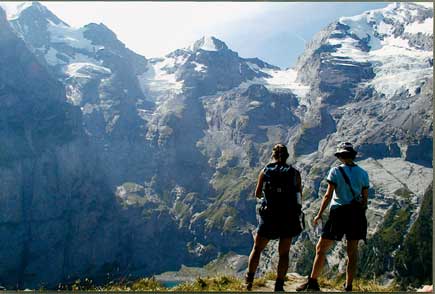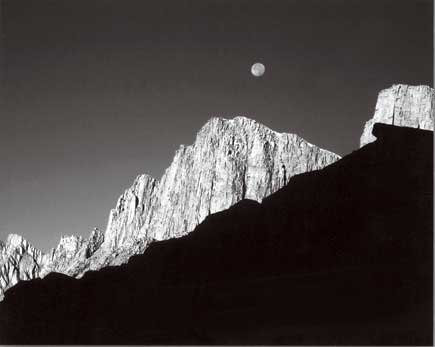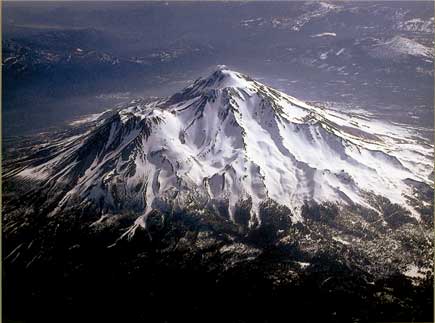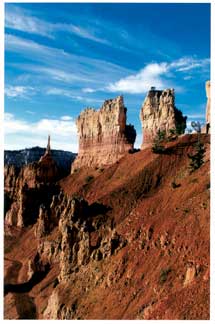Anyone who loves shooting scenics probably enjoys capturing the grandeur of
mountains. As with most landscapes, it's best to photograph mountain scenery
very late in the afternoon or very early in the morning. Some of the best high-country
photos are shot by photographers who get up before daybreak or stop shooting
only after dark. You'll find that an otherwise dramatic peak can look
a little flat and uninteresting during the middle of the day.
 |
A
panoramic view of a mountain range in Glacier National Park, Montana.
Reader photo by Mario Giannone, Buffalo Grove, IL
|
|
The low light at dusk and dawn lends texture, depth and form to photos of
mountains. You can also get great shots in varying weather conditions--don't
put your camera away simply because the weather has turned cloudy. Don't
go out in a blizzard or heavy rain, but look for dramatic clouds building before
a storm, or the sun peeking through clouds afterward. You can also get some
dramatic pictures of mountain peaks disappearing into clouds or fog.
At high altitudes, a phenomenon sometimes occurs called alpenglow. This warm
glow appears when blue and green wavelengths are scattered by the atmosphere
and a little red light dominates, which briefly bathes a mountain in warm, reddish
hues. Alpenglow can illuminate the clouds around mountains as well.
|
|
Jagged
red-rock formations at Bryce National Park, Utah.
Reader photo by Leonard Rapoport, Hazlet, NJ
|
|
High altitudes can also result in a lot of atmospheric haze because of the
excessive ultraviolet light. Sometimes this haze can be rendered attractively
in photos, such as images of mountains that graduate from a deep purple to distant
peaks that appear to become progressively paler shades of blue. But if haze
becomes a problem, try using a polarizing filter. If you have a compact camera,
you may not be able to attach this filter to the front lens element, but you
can hold it in front of your lens and rotate it to get the desired effect. A
polarizer will deepen the color of the sky, minimize haze, and generally enrich
the colors in a scene. This filter is most effective when the sun is at a right
angle to your camera. At very high altitudes, the sky can appear almost black
when you use a maximum amount of polarization, so adjust the amount by turning
the outer ring, and experiment by taking pictures with and without this filter.
 |
Including
people will add interest and scale to your mountain photos.
Reader photo by Cheryl Gosson, Ottawa, Canada
|
|
How many times have you traveled to a beautiful spot to photograph mountains,
only to find that the majesty of the mountains has disappeared somewhere in
the translation to film or a memory card? Sometimes shooting a picturesque scene
of a snow-covered peak is not enough. Look for a visual clue that reveals the
true magnitude of the scene around you. Showing scale can really add interest
to your photos of mountain peaks and ranges. One way to do this is to set your
camera's zoom lens to a wide-angle setting in the 24--35mm range,
and include a foreground subject, like a group of flowers or a hiker. If you
have a zoom lens, adjust it until you get a pleasing effect; sometimes wide-angle
shots make distant mountains appear to be diminished rather than tall and grand.
If you have a compact camera with a fixed-focal-length lens, you'll have
to move around to find the angle and distance that work best for you.
 |
A
full moon over peaks near Mount Whitney, California.
Reader photo by Jeff Pedigo, San Francisco, CA
|
|
To make the mountains appear more grandiose, adjust your lens to a moderate
telephoto setting, and find a middle-ground subject for scale, like a building
or grouping of pine trees. Telephoto lenses used at a great distance compress
the space in your photos and the apparent size of the mountains will be enhanced.
Last but not least, always protect your camera equipment when your mountain
excursions take you to snow or other inclement weather. Put your camera in a
plastic bag or a warm, dry backpack and bring it out only to take pictures.
 |
This image of Mount Shasta, California, was taken from the cockpit
of a plane this photographer was piloting.
Reader photo by Robert Wilbourn, Desoto, TX
|
|
Readers are encouraged to submit photos to our monthly Point & Shoot HomeWork
Assignment feature. Please see the table of contents for the location of the
entry coupon, which lists topics and more details.
Source: http://www.shutterbug.com





